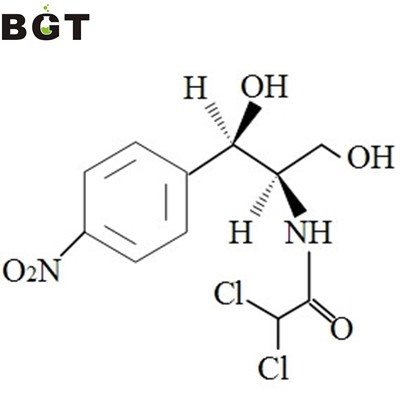Pharmaceutical Products
Description
What is Chloramphenicol?
Chloramphenicol is a prototypical broad-spectrum antibiotic. It is a bacteriostatic made of Streptomyces venezuelae by David Gottlieb and became available for clinical application in 1949. It was the first antibiotic to be manufactured synthetically on a large scale.
The pharmacokinetics and action mechanism of Chloramphenicol
Chloramphenicol is a small molecule which is extremely lipid soluble and relatively unbound to protein. It works by inhibiting protein synthesis through preventing protein chain from extending by inhibiting the peptidyl transferase activity of the bacterial ribosome. It specifically binds to A2451 and A2452 residues in the 23S rRNA of the 50S ribosomal subunit, preventing peptide bond formation. While chloramphenicol and the macrolide class of antibiotics both interact with ribosomes, chloramphenicol is not a macrolide. It directly interferes with substrate binding, whereas macrolides sterically block the progression of the growing peptide.
The distribution of Chloramphenicol in the body is not uniform. It is metabolized by the liver to chloramphenicol glucuronate, which is inactive, and the majority of the chloramphenicol dose is excreted by the kidneys as the inactive metabolite, chloramphenicol glucuronate. As a result, the highest concentrations are in the liver and kidney, and the lowest concentrations are in the brain and cerebrospinal fluid. When the meninges are not inflamed, the concentration achieved in brain and cerebrospinal fluid is around 30-50%, while the percentage rises to 89% when the meninges are inflamed.
Moreover, chloramphenicol increases the absorption of iron.
Read More
Banff Green Technologies, Inc.
diethyl fluoromalonate, dimethyl fluoromalonate, d-p-methyl sulfone phenyl ethyl serinate, florfenicol, d-(-)-threo-2-amino-1-(4-nitrophenyl)-1,3-propanediol, chloramphenicol
Address: Floor 29, CapitaMalls Plaza, No. 6088 Humin Rd., Minhang Dist.,,
Shanghai, Shanghai
China, 201100
Tel: 86-21-54795870
Fax:


